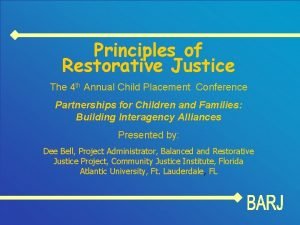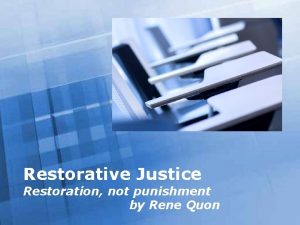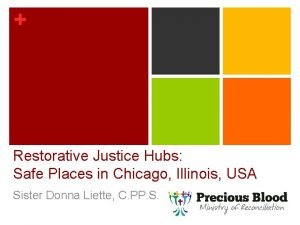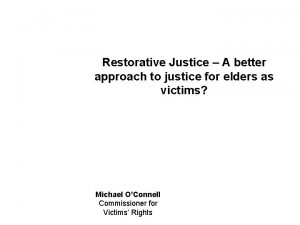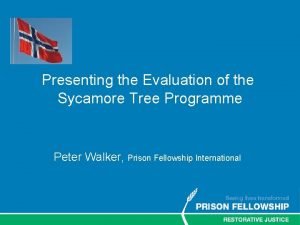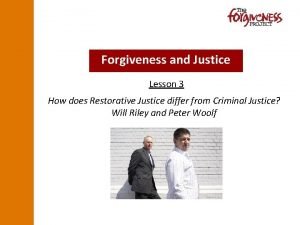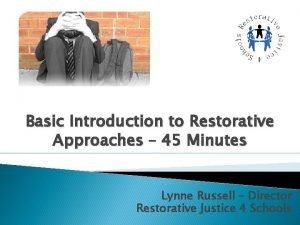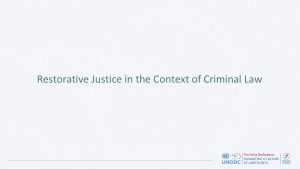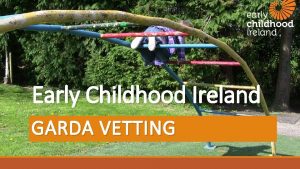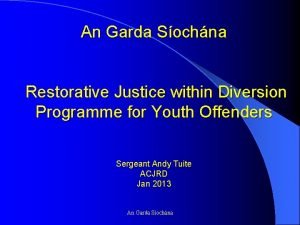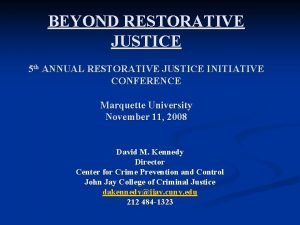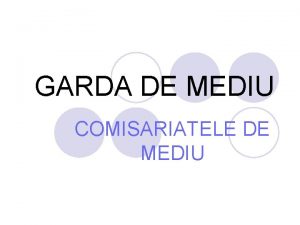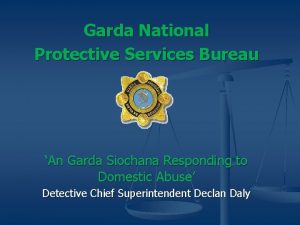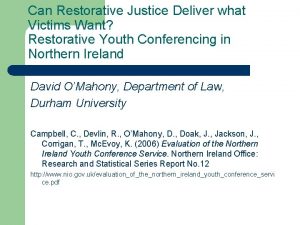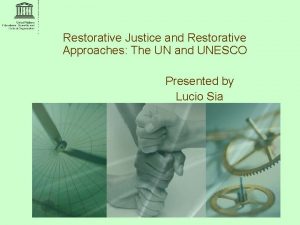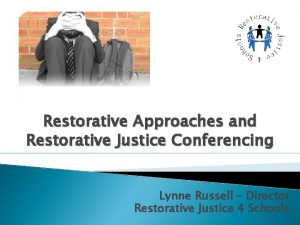Restorative Justice The Garda Model Young Offending Sergeant

















- Slides: 17

Restorative Justice The Garda Model (Young Offending) Sergeant Andy Tuite Garda National Juvenile Office The Law Society Tuesday 16 th October 2007

Juvenile Diversion Programme • Juvenile Liaison Officer (JLO) scheme in existence since 1963 • 2001 Act placed Diversion Programme on statutory basis • Created the position of Director of Diversion Programme (Garda Superintendent) • Juvenile Liaison Officer (J. L. O. ) now has statutory functions (88 Gardai and 8 Sergeants and now to be increased by 28 Gardai over the next 4 years) • Introduced the concept of Restorative Justice into the Juvenile Justice system Restorative Cautions (S 26) Restorative Conference (S 29)

The Diversion Programme • S 18 - Every child shall be considered for admission to the diversion programme • • Criteria for admission to Diversion Programme - accept responsibility for behaviour - 10 yrs and under 18 -consent The Diversion Programme is a means of dealing with children who offend in a manner other than by way of prosecution and is designed to divert the child from the courts and away from further offending

Diversion Process • Offence detected & offender is child • Investigating Garda fills out referral • Director decides on action to be taken • J. L. O. calls to home of child

Action to be taken • No further action • Informal caution • Formal Caution (12 months supervision) • Not suitable for inclusion v No admission v Repeat offender v Very Serious Offences and not in public interest v Excluded by regulation • Return to local Superintendent for prosecution

The Garda Model 2 types of Restorative Intervention • Section 26 – Restorative Caution allowing for the presence of a victim when a formal caution is being administered The victims presence is not an essential ingredient for the event to be restorative • Section 29 – Garda Conference – bringing together family and relatives as well as agencies to formulate an action plan for the child

Restorative Process • Offence detected and referral sent to National Juvenile • • Office Director/JLO recommends “explore” restorative First person to consider/discuss with is the offender If positive discuss with victim If victim not present victims perspective represented by surrogate such as victim support, family member, Garda or letter. “Victimless” crimes drugs, public order, road traffic Event preparation Further meetings with offender/victim

Role of JLO • Home JLO; in area where child lives explores the options and sets up the meeting • Away JLO; chairs the meeting

Restorative meeting • Venue; halls, churches, Garda Station, schools, • • • hotel Room lay out and seating Arrivals Water and tissues Refreshments Breakout rooms Departure plan

Meeting process • Introduction and ground rules • Offender speaks first • Victim • Offenders support • Victim support • Discussion • Agreement • Plan

Types of Cases • Public Order • Robbery • Assault • Harassment • Supply of drugs • Criminal Damage • Burglary

Number of Restorative Cases Year Total 02 03 04 05 06 07 29 118 177 262 309 235

Distinguishing features of The Garda Model • Protection from double jeopardy. The decision has • • already been made to caution Confidentially of proceedings Specially trained personnel Intervention occurs early High level of training – restorative justice facilitator skills, mediation skills and victim awareness. Monitoring committee appointed Victim needs given consideration as well as offender Offender accountability

Evaluation Restorative Justice Programme • Pilot Programme 68 cases 1999 -Aug 2001 • New evaluation of 147 cases from May 2002 -December 2003 (O’Dwyer)

Preliminary findings • Over 93% victim satisfaction • J. L. O. very positive – better way • Investigating Garda – very positive • Child who offended - Not an easy option • Re-offending rates 1/3 • Garda Model had evolved

Garda Model • Legislated for in Children Act; ensures confidentiality/ethos/access to • • • information Voluntary; decision to divert already made, non engagement does not go to court Use of two JLO’s at event Gardai that are full time dedicated to working with youth and remain in post long term High level of training and understanding of RJ Part of a continuum of involvement with child Flexible in meeting needs of child Not generally scripted Offender and victim orientated Monitoring and evaluation ongoing

SUMMARY • The Garda Model of RJ is working well and is being well • • • received by JLO’s and Gardai in general Restorative Justice is not a panacea and should not be over sold It is not for every case It is time and resource consuming Requires training if it is to be effective It is an additional tool It can be powerful and effective in the right place
 Principles behind restorative justice
Principles behind restorative justice Restorative justice powerpoint template
Restorative justice powerpoint template Social justice and community action
Social justice and community action San diego restorative justice
San diego restorative justice Restorative justice hubs chicago
Restorative justice hubs chicago Pros and cons of restorative justice
Pros and cons of restorative justice Sycamore programme
Sycamore programme Peter woolf restorative justice
Peter woolf restorative justice Restorative justice script
Restorative justice script Social discipline window
Social discipline window Principles of restorative justice
Principles of restorative justice Garda vetting form early childhood ireland
Garda vetting form early childhood ireland Garda schools programme
Garda schools programme Krones taicang
Krones taicang La magnifica del garda
La magnifica del garda Jlo garda
Jlo garda Garda cyber crime unit contact
Garda cyber crime unit contact Avoid the offending allergen that
Avoid the offending allergen that
